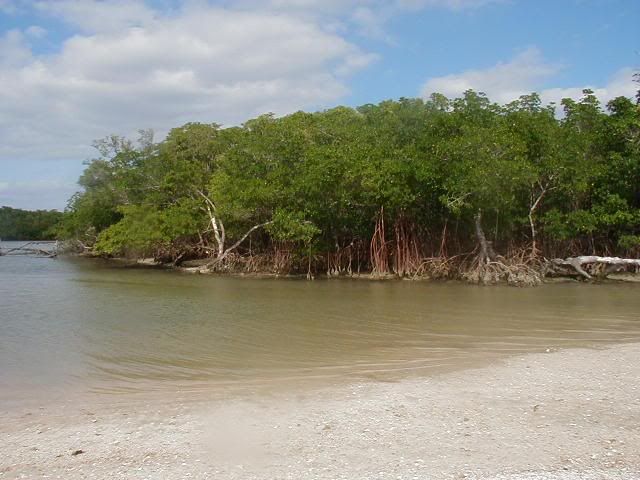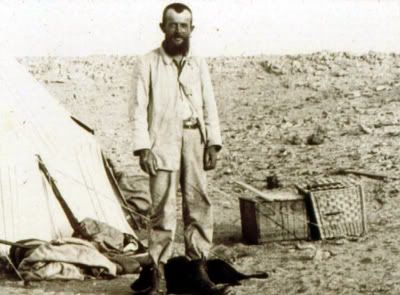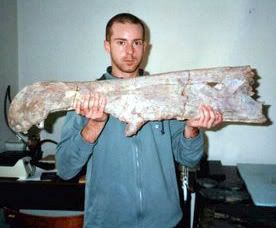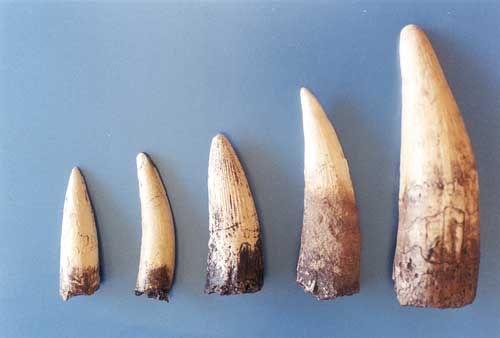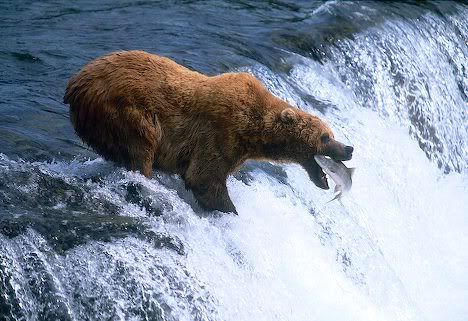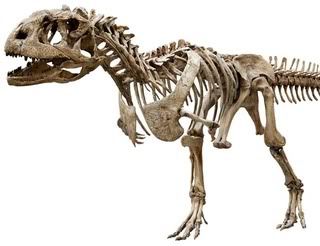Tuesday, July 28, 2009
Off to the field.
Will be back on the 9th of August; with luck I'll have photos and such of the trip!
Sunday, July 26, 2009
Dinosaurian death in decidedly drenched dirt.
Just got done reading a paper entitled Mud Trapped Herd Captures Evidence of Distinctive Dinosaur Sociality, and it's a really cool read; especially if you have an interest in both taphonomy (what happens to an animal--in this case fossilized--after it dies) and dinosaurian behavior.
An excavation done in the Ulansuhai formation (late Cretaceous in age) of inner Mongolia turned up a group of at least thirteen separate specimens of the ornithomimid Sinornithomimus who were all found on a single geologic horizon and in very close proximity. Utilizing the sort of detective work essential for a field like paleontology (like a sleuth in some crime thriller, we have to use as many tools and conceptions as we can to get to the bottom of the case!), the paleontologists steadily unearthed a fascinating story.
First off, the geology of the locality held many different hints of information--like the presence of fine-grained layered deposits of rock and dirt that would alternate between very thick and very thin sections laid down in such a way as to suggest a non-fluvial (non-river caused) depositional environment. Various fossil ostracods (a sort of shrimp-like animal) helped support this.
However, the rocks told more of a story--in one layer in particular, this lakeside was drying up and fast--leaving various features of an arid environment (evaporites and the like). It was this horizon where the dinosaurs were found.
Twelve of the thirteen ornithomimids were found in an upright posture, stuck in a highly viscous material created by certain kinds of drying clays. Most (ten out of thirteen) of the skeletons were angled between 87º and 188º, which also lends itself towards a mass death at a single instant in time (a chance alignment for that number of specimens within that range of direction is very, very low).
One of the many really neat things about this find is the fact that the directionality the animals died in greatly influenced the bones and pieces that were missing from the skeletons--animals that died with their belly facing the ground most often had their gastralia (ribs found in front of the gut) and their stomach contents at the time of death preserved, but were missing dorsal (back) vertebrae and their respective ribs. On the other hand, the animal that was found on its left side had right rib elements missing. This is highly indicative of scavenging--after death and before complete burial, the exposed surfaces were eaten by opportunistic feeders.

Interestingly, the ilium (the largest of the hip bones) was missing in most of the specimens, and --though it can't be said for certain--this is also likely due to scavenging given that a. it probably would have been exposed to the surface on most of the specimens and b. it has a massive amount of muscle tissue to attract local carnivores. However, several of the Ilia appear to have weathered off, and very well may have survived to the point of burial.
Bone histology studies (research into the microstructure of the animal's bones) as well as relative size comparisons show that these animals were all juveniles or sub-adults, which is absolutely awesome in many ways--many bone beds containing the skeletons of non-avian juvenile dinosaurs have been found before, but because there was little taphonomic evidence to say for certain that they dead as a group or if it was a chance washing, this aspect of dinosaurian behavior was still slightly up in the air. But because this bone bed also contains similar age ranges, and the detail of taphonomy is so intense, it helps prove that previous similar finds were no accident!
All of this information helps us paint a picture of the scene--a drying lake bed, many millions of years ago attracts a roaming group of juvenile Sinornithomimus (the adults and infants are presumably nesting and traveling elsewhere). They're parched, thirsty beyond belief--and in temperatures well over 100 degrees, water is not common. They reach the watering hole, and though the water is stagnant and awful tasting, it was the most water they've had in days--but something goes wrong: they're stuck. They struggle, letting out distress calls in hopes that others are near--and as they try to pull themselves away from the sticky mud's grasp, they push themselves further in yet. After what could be hours, they fall over dead--struck by overexerting themselves in the scalding desert heat. The lake bed progressively dries further, and scavengers take the opportunity to snag a meal of what's exposed. Eventually the bodies are entirely buried with mud, and become fossilized over the aeons--lost in memory until a chance encounter with an entirely different group of bipedal animals, who map and detail their discovery for the world to see.
Reference--
Varricchio, D.J., Sereno, P. C., Zhao, X., Tan, L., Wilson ,J. A.,and Lyon, G. H.2008.Mud−trapped herd captures evidence
of distinctive dinosaur sociality. Acta Palaeontologica Polonica 53 (4): 567–578.
Tuesday, July 21, 2009
Dinosaur of the Week--Spinosaurus.
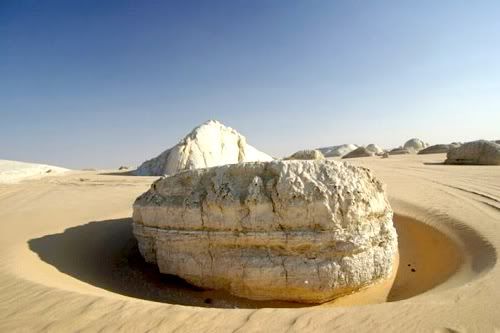
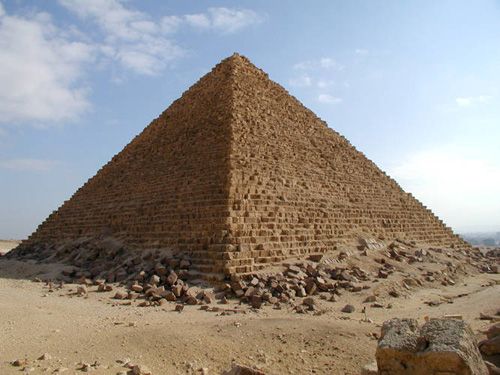
And this, roughly, is Egypt 110 million years ago.
Through a study of its geology and evaluations of the local fossil record, we've determined that in aeons past Egypt was very similar in appearance to the modern day Florida Everglades, with scattered mangrove swamps and intensely widespread vegetation.
However, there were some fairly recognizable differences. For example, you're not likely to find this guy in Florida--
Spinosaurus, a giant theropod dinosaur famously featured in Jurassic Park III. Spinosaurus is the last known member of a group of dinosaurs known as the Spinosauridae, whose members stretched from modern day Europe (Baryonyx) to Niger and Morocco in northwestern Africa (but was then called Gondwana). Though we have slightly more information on the animal now than has been the case in the past, Spinosaurus is still something of an enigma, with an absolutely enthralling and fascinating history. It was first discovered in the isolated deserts of Egypt by German paleontologist Ernst Stromer in 1912, known from a fragment of its skull and several vertebrae characterized by an absolutely massive spinous process (the portion of the top of the vertebrae that sticks up, or as we paleontologists unnecessarily put it 'extends dorsally') that stretched up to seven feet in length--these vertebrae would form together to create a large sail structure. Along with the holotype (the original find that a group of dinosaurs is based on) of Carcharodontosaurus, Stromer left the Egyptian desert, and had the specimens shipped back to Germany years later (after running through many hurdles to get them returned).
However, when they finally arrived, Stromer saw practically every single specimen in pieces--destroyed by the bumpy roads and inefficient carrying. For the next several years, he would reassemble and scientifically document and describe each of them, taking both photographs and producing detailed drawings.
But for all his work, every one of them were demolished into fine dust during World War II, when an Allied bombing run missed its mark and destroyed the museum that contained them. For years, it was all that had been found of this dinosaur, and was shrouded in mystery through those few remaining photographs and drawings. But very recently (within the last couple decades), new specimens of Spinosaurus have been unearthed, helping shed some light on the animal. These find include several more vertebrae, and and a couple jaw fragments (one of which--a bottom jaw, or 'dentary'--may represent a new species of the genus).
By the shape of its skull and teeth, it's been suggested that Spinosaurus was a largely piscivorous (fish-eating) animal, but was large enough (estimates put it as much as 58 feet long) that it could have certainly predated on smaller prey as well (a modern day analog would be the Grizzly Bear).
Monday, July 20, 2009
Dinosaur bite marks--
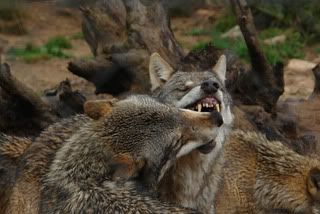
One aspect of paleontological research that has always fascinated me is how amazingly similar many of the events that occurred countless millions of years ago are to those found in modern ecosystems--in this case that of the countless and wide-varied interactions between predators and their prey, and even those between the predators themselves. One of these behaviors is something known as 'head biting'--a behavior observed amongst living animals in which competing rivals (over a mate, territory, a corpse, many things) fight amongst each other for control over whatever it is that they have their eyes set on. And because each of these animals are trying to assert their dominance over the other and would like to keep themselves as intact as possible, the head is a frequent target (keeping the rival in their sights). Also, because carnivores of aeons past had the same goals in mind as those living today (self-preservation and reproduction) and very similar tools to do so with (teeth and jaws!), they very likely ran into similar encounters and bouts of combat. As it turns out, we can find signs of these encounters throughout the fossil record!

 This is a drawing of the partially reconstructed skull of an animal called Sinraptor, found in the deserts of northwest China. Each of the dark black lines outline the path of bite wounds that Canadian paleontologist Phillip Currie believes were caused by a conspecific (another Sinraptor). What is unique and so absolutely cool about this find is the fact that it allowed Currie to reconstruct the event in fascinating detail (given that it occurred over a hundred million years ago!)--two carnivorous dinosaurs faced off over a number of possible things (food, territory, etc.)--the tensions breaks, and one of the pair snaps its teeth at the other on the right side of the face and lower jaw with the right side of its mouth (measured by the angle and direction of the bite marks). However, as evidenced by the fact that the injuries were partially healed we know that the dinosaur in question (somehow) fled the scene. On the other hand, not all conspecific combat avoids mortality. In fact, we have evidence of outright cannibalism by this guy--
This is a drawing of the partially reconstructed skull of an animal called Sinraptor, found in the deserts of northwest China. Each of the dark black lines outline the path of bite wounds that Canadian paleontologist Phillip Currie believes were caused by a conspecific (another Sinraptor). What is unique and so absolutely cool about this find is the fact that it allowed Currie to reconstruct the event in fascinating detail (given that it occurred over a hundred million years ago!)--two carnivorous dinosaurs faced off over a number of possible things (food, territory, etc.)--the tensions breaks, and one of the pair snaps its teeth at the other on the right side of the face and lower jaw with the right side of its mouth (measured by the angle and direction of the bite marks). However, as evidenced by the fact that the injuries were partially healed we know that the dinosaur in question (somehow) fled the scene. On the other hand, not all conspecific combat avoids mortality. In fact, we have evidence of outright cannibalism by this guy-- Majungasaurus, a large theropod dinosaur that lived in modern day Madagascar 70-65 million years ago. One find in particular viscerally fleshed out the defleshing of one such animal by another of its own species--the tooth marks on the bone match the dinosaur's teeth perfectly. 
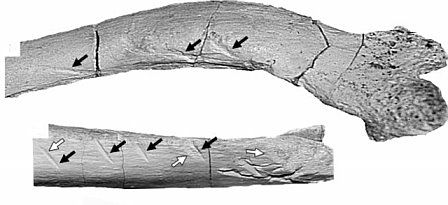 Looking at today's ecosystems, this sort of thing is none too surprising--it occurs more frequently than many realize. What is exceptional (being that fossilization alone is very rare) is the signs of its existence being preserved after so long!
Looking at today's ecosystems, this sort of thing is none too surprising--it occurs more frequently than many realize. What is exceptional (being that fossilization alone is very rare) is the signs of its existence being preserved after so long!  However, encounters were certainly not limited between the carnivorous dinosaurs themselves--we have also uncovered fantastically detailed evidence of predator/prey interactions (both of animals that were scavenged and animals that escaped attack).
However, encounters were certainly not limited between the carnivorous dinosaurs themselves--we have also uncovered fantastically detailed evidence of predator/prey interactions (both of animals that were scavenged and animals that escaped attack).  At the centerpiece of a pseudo-debate involving the feeding behavior of the Late Cretaceous dinosaur Tyrannosaurus is a skeleton re-described by paleontologist Ken Carpenter (which was first discovered by a man called Barnum Brown in 1933)--a series of its caudal (tail) vertebrae was fractured, with at least one portion of the 'spinous process' completely broken and still several others kinked. On these spines were several tooth marks that match the exact shape and size of those belonging to Tyrannosaurus. But, because the bones show signs of healing, we know that it escaped for at least some time (and possibly died due to a bone infection) created by the bite.
At the centerpiece of a pseudo-debate involving the feeding behavior of the Late Cretaceous dinosaur Tyrannosaurus is a skeleton re-described by paleontologist Ken Carpenter (which was first discovered by a man called Barnum Brown in 1933)--a series of its caudal (tail) vertebrae was fractured, with at least one portion of the 'spinous process' completely broken and still several others kinked. On these spines were several tooth marks that match the exact shape and size of those belonging to Tyrannosaurus. But, because the bones show signs of healing, we know that it escaped for at least some time (and possibly died due to a bone infection) created by the bite. 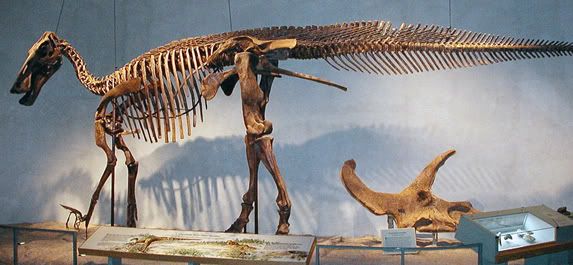
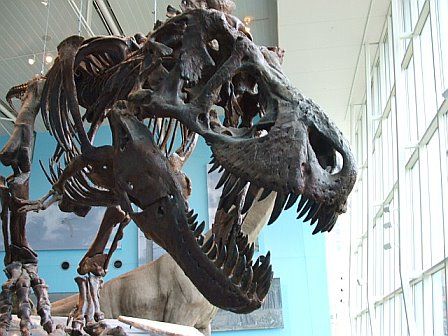 Also like many carcasses found in the wild today, bones of various dead animals would have scattered to the four winds by both assorted predators and scavengers, and as much of the bone as possible would have been picked clean. One such find is quite indicative of just that--a Triceratops pelvis collected by the Museum of Pennsylvania with a bare minimum of twelve bite marks, and as many as 33.
Also like many carcasses found in the wild today, bones of various dead animals would have scattered to the four winds by both assorted predators and scavengers, and as much of the bone as possible would have been picked clean. One such find is quite indicative of just that--a Triceratops pelvis collected by the Museum of Pennsylvania with a bare minimum of twelve bite marks, and as many as 33.

 Looking at today's ecosystems, this sort of thing is none too surprising--it occurs more frequently than many realize. What is exceptional (being that fossilization alone is very rare) is the signs of its existence being preserved after so long!
Looking at today's ecosystems, this sort of thing is none too surprising--it occurs more frequently than many realize. What is exceptional (being that fossilization alone is very rare) is the signs of its existence being preserved after so long!  However, encounters were certainly not limited between the carnivorous dinosaurs themselves--we have also uncovered fantastically detailed evidence of predator/prey interactions (both of animals that were scavenged and animals that escaped attack).
However, encounters were certainly not limited between the carnivorous dinosaurs themselves--we have also uncovered fantastically detailed evidence of predator/prey interactions (both of animals that were scavenged and animals that escaped attack).  At the centerpiece of a pseudo-debate involving the feeding behavior of the Late Cretaceous dinosaur Tyrannosaurus is a skeleton re-described by paleontologist Ken Carpenter (which was first discovered by a man called Barnum Brown in 1933)--a series of its caudal (tail) vertebrae was fractured, with at least one portion of the 'spinous process' completely broken and still several others kinked. On these spines were several tooth marks that match the exact shape and size of those belonging to Tyrannosaurus. But, because the bones show signs of healing, we know that it escaped for at least some time (and possibly died due to a bone infection) created by the bite.
At the centerpiece of a pseudo-debate involving the feeding behavior of the Late Cretaceous dinosaur Tyrannosaurus is a skeleton re-described by paleontologist Ken Carpenter (which was first discovered by a man called Barnum Brown in 1933)--a series of its caudal (tail) vertebrae was fractured, with at least one portion of the 'spinous process' completely broken and still several others kinked. On these spines were several tooth marks that match the exact shape and size of those belonging to Tyrannosaurus. But, because the bones show signs of healing, we know that it escaped for at least some time (and possibly died due to a bone infection) created by the bite. 
 Also like many carcasses found in the wild today, bones of various dead animals would have scattered to the four winds by both assorted predators and scavengers, and as much of the bone as possible would have been picked clean. One such find is quite indicative of just that--a Triceratops pelvis collected by the Museum of Pennsylvania with a bare minimum of twelve bite marks, and as many as 33.
Also like many carcasses found in the wild today, bones of various dead animals would have scattered to the four winds by both assorted predators and scavengers, and as much of the bone as possible would have been picked clean. One such find is quite indicative of just that--a Triceratops pelvis collected by the Museum of Pennsylvania with a bare minimum of twelve bite marks, and as many as 33.
Subscribe to:
Posts (Atom)



